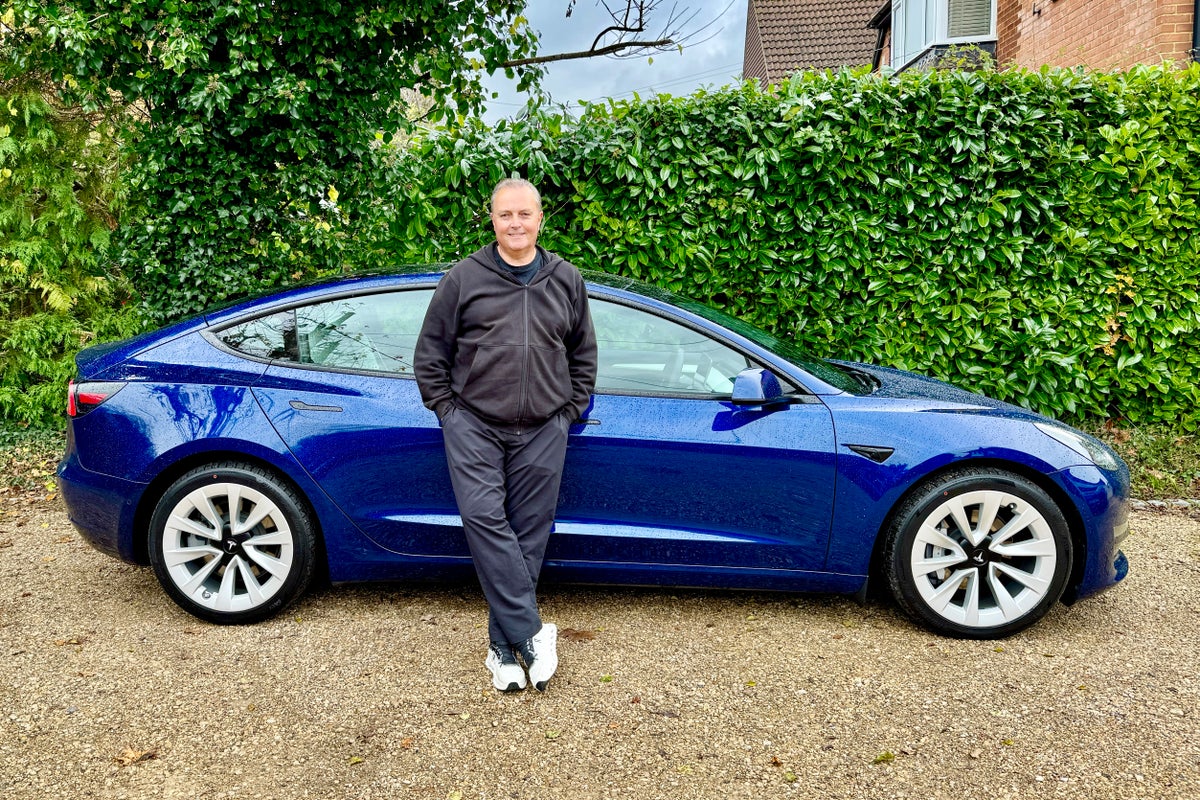
The Tesla Model 3 and Model Y have consistently ranked among the best-selling cars in the UK for years, with the Model Y the UK’s favourite new electric car for the past two years. However, the Model 3 was launched before the Model Y, and that means there are plenty of used Tesla Model 3s available on the market with prices starting at around £10,500 on used car websites.
You’ll pay more for the best cars on Tesla’s Certified Pre-Owned scheme (currently prices start at just under £20,000) as these cars are newer, thoroughly checked and with the latest software – plus they come with a Tesla warranty.
Countless potential buyers are wondering whether a pre-owned Tesla Model 3 would be a wise purchase, so to find out whether a used Tesla is worth spending money on, I decided to see what it’s like to live with a second-hand model. How quickly has a car like this aged? How has the build quality stood up? What’s the technology like to live with? And crucially, what has time and mileage done to the battery and range of the car?

For our tests, I’m running a Long Range All-Wheel Drive 2021 Model 3 from Tesla’s official used car scheme – Tesla Certified Pre-Owned – to answer all of these questions and more. I’ll be updating my used Tesla review as I get more hands-on experience with the car, so check back in to see how the second-hand EV performs under real-world conditions.
Tesla Model 3 (used): From around £10,500, Tesla.com
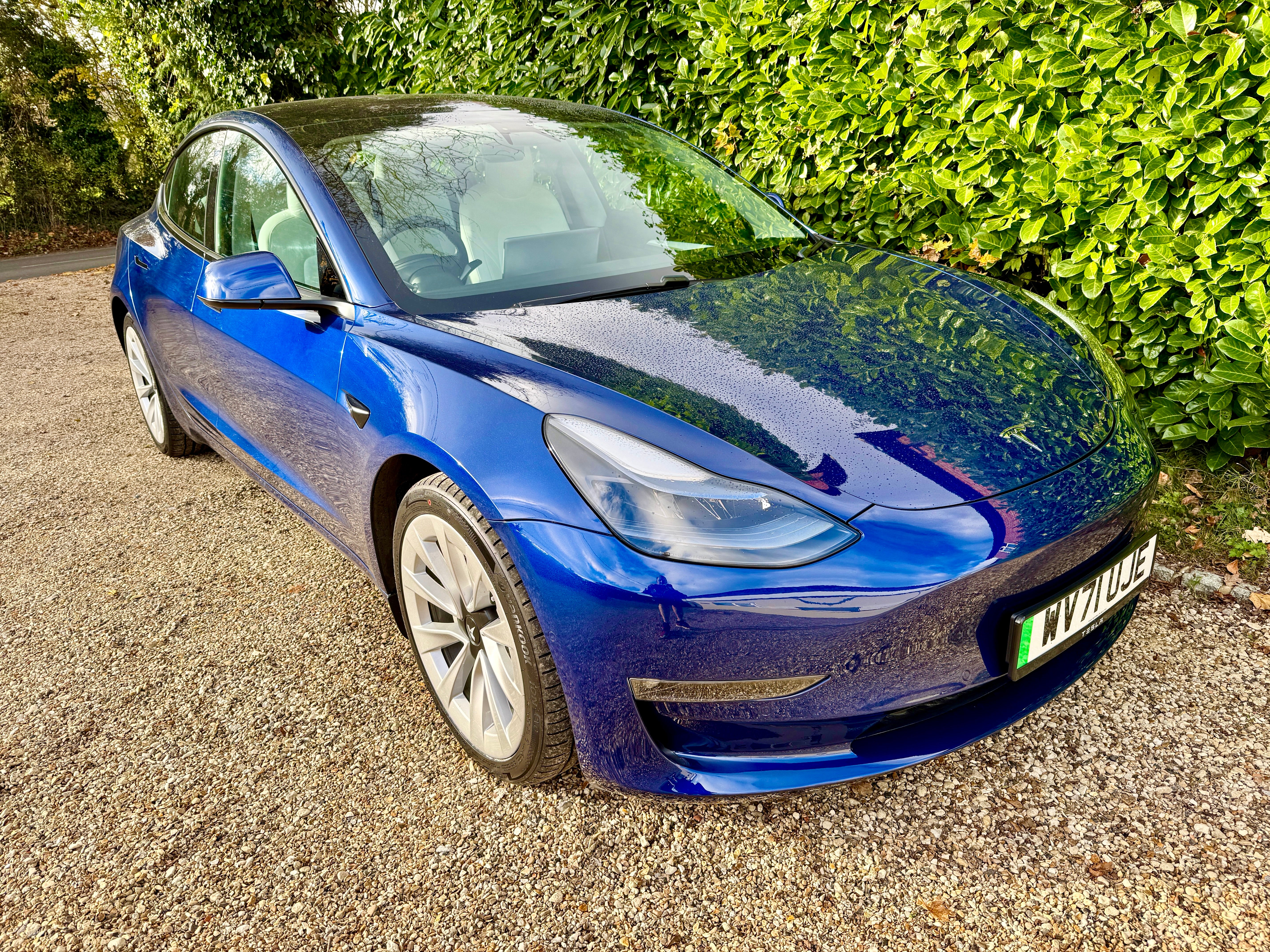
Week ten – the final verdict: should you consider a used Tesla Model 3
The mark of any car is how much you miss it when it’s gone, and there is a Tesla-sized hole in my heart now my Model 3 has gone on to find its next owner.
It turned out to be a remarkably easy car to live with. It wasn’t perfect – no car is – but I enjoyed driving it, as did my wife. It was impressively efficient, the tech all works seamlessly and even the quality – a previous Tesla foible – was okay.
As a used car, I could not have wished for more. My car turned up – delivered to my driveway – in absolutely perfect condition. I’ve always been slightly hesitant about Tesla’s white interiors, but mine was absolutely spotless after other people sitting in the car for 24,000 miles over three years. The bodywork was absolutely perfect, too – whether any repair work had been carried out, I neither knew nor could spot any signs. In fact, my wife and many friends just thought it was a brand new car.
That also applies to the software – for all intents and purposes, this was the same as a brand new car. The software was up-to-date (and continued to update to bring new functionality – notably a Tesla app for my Apple Watch) and all the clever features that you get with a new car, you get with an older one.
At some stage the hardware in my car will, no doubt, age to a level when the latest tech won’t be able to be applied, but I’m pretty confident that most of the more important features you can get in a brand new Model 3, you can get in my three year-old one.
What you do get in a new Model 3 is a better ride. The biggest criticism I have of the first generation Model 3 (of which mine was one) is the ride quality. I learned to live with it, but if you have rear passengers who are sitting pretty close to the rear axle, they’ll complain that the bumps make it a bit uncomfortable at times – certainly more than it is sitting in the front.
When it comes to range and efficiency, as you will see from the picture down the page, my car was showing a total range when fully charged of 323 miles. That’s impressive for any EV, let alone one that’s three years old and being run through the coldest months of winter.
I probably could have achieved close to those 300 miles in reality, if I had wanted to run the battery down close to zero. But only once did I rue running an EV: when I had completed one 250 mile round trip and needed to set straight off on another. What I should’ve done – and could’ve done – is stop off at the Tesla Supercharger not too far from me to top up the battery. A schoolboy error, really, from the need to get home and let the dog out.
My only other criticisms of the Tesla Model 3 are minor. The indicators don’t cancel quite as effectively as on some other cars. I still like to have a car with Apple CarPlay in it, which is not an option on a Tesla. Tesla’s own systems can manage the same functions, but phone calls and responding to messages aren’t quite as intuitive. Linking the excellent sound system to my Apple Music account meant I could access all my music and playlists easily, though.
Otherwise, Tesla’s Enhanced Autopilot semi-autonomous driving worked better than most other systems I’ve encountered – although you still have to take over control occasionally. And I really enjoyed the Tesla to drive – it feels like a brilliantly engineered car where software, major controls and drive system all work well together. It’s fun to drive! And I absolutely love that deep front windscreen that gives you a real widescreen view out – as it should with an EV without an engine under the bonnet.
The app is easy to use and really useful, while the games and videos you can play on the car’s screen add to the fun.
We have two other Teslas in the extended Fowler family. You can see how Ralph in the US gets on with Full Self-Driving in the US if you scroll down the page, while my nephew here in the UK has also bought a used Model 3, but from a used car dealer rather than through Tesla’s Certified Pre-Owned scheme. And he’s very, very happy.
So would I recommend a used Tesla to you? Based on my experience, yes I would. I’d be inclined to buy through Tesla’s scheme to ensure I got one of the best cars and the best preparation – and the Enhanced Autopilot, too.
If you’re thinking of your first step into EV ownership, I reckon a used Tesla Model 3 could well be the perfect introduction to a new world of efficient, lower cost (when it comes to the ‘fuelling’, at least), fun car ownership.
Week seven – a second opinion and Tesla preconditioning in the cold weather
My wife Victoria doesn’t normally show much interest in the cars I have on our driveway. She’s perfectly happy with her petrol Peugeot 2008 and its heated seats that are on come rain or shine.
She has, however, taken something of a liking to the Tesla Model 3. When it first arrived, she couldn’t believe that it was a used car from Tesla’s Certified Pre-Owned scheme, such was the quality and preparation of the car, and the fact that a Tesla still tends to look more contemporary than many newer models with its minimalist interior and high-tech, constantly-upgraded touchscreen.
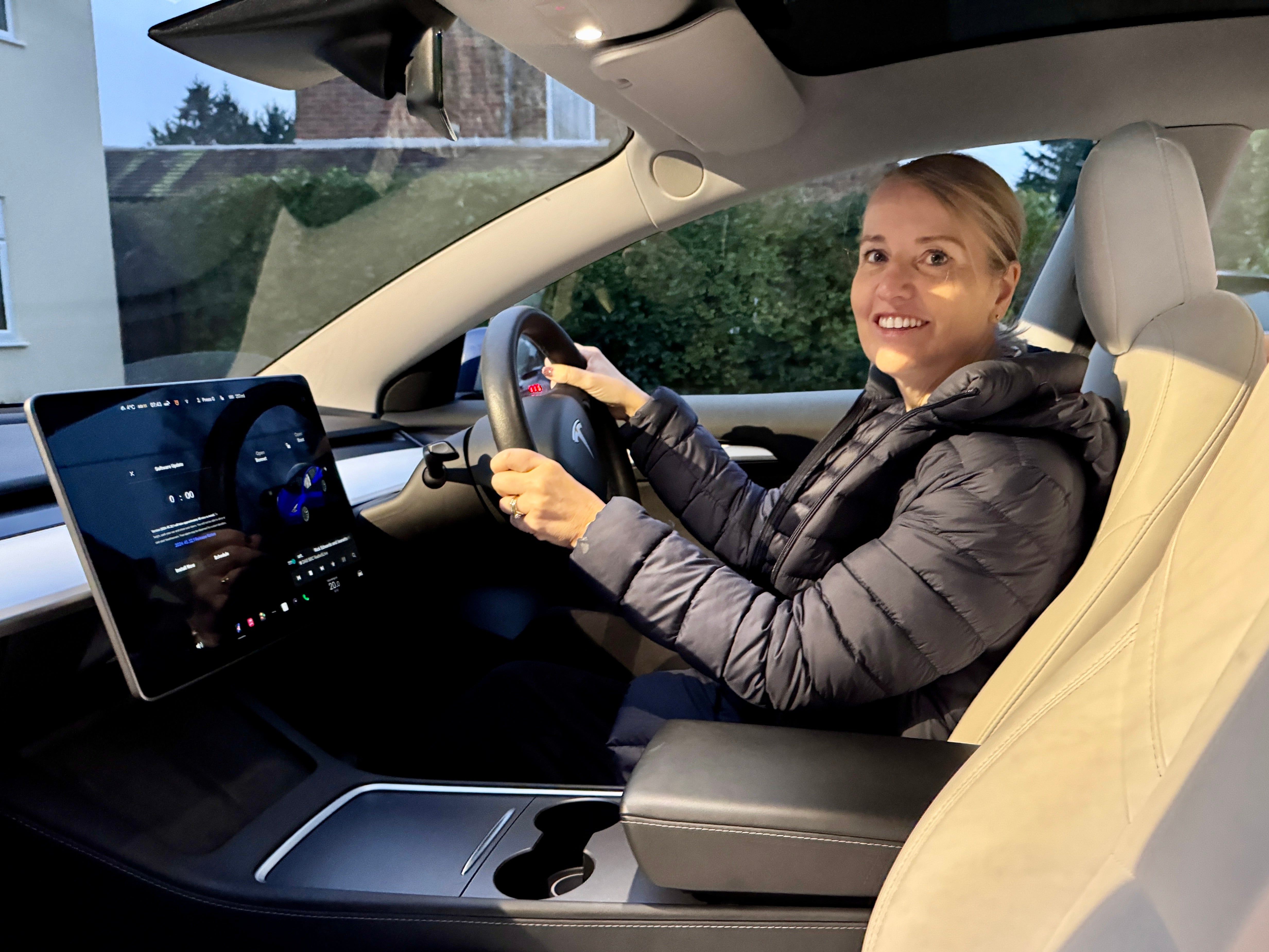
She likes the view out, too, with the deep front windscreen giving an excellent view forwards, and the view out of the back with the panoramic roof flowing into the rear screen being pretty good, too.
But it’s the cold weather that’s really seen another Tesla fan join the family, especially the ability to precondition the car before you get into it. The picture below shows the difference between her Peugeot and my Tesla on a cold morning. We were due to leave at roughly the same time and I’d used my app to set a departure time in the Tesla for 7.30am. As you can see, the Tesla was not only clear of ice, but the cabin was toasty with the heated seats and heated steering wheel already both on. Her Peugeot, on the other hand, was going to need a fair bit of de-icer and scraping before she could take a cold journey to work – just ten minutes down the road.
You can probably guess what happened next. The Tesla was hers for the day, while I was left with the 2008...
Most EVs will have an accompanying app that allows you to pre-heat the cabin, but the Tesla app is one of the best: it’s full of features and easy to use. It’s frequently updated, too, as you can read below when Tesla Summon and an Apple Watch app both appeared in the app. Setting a departure time not only pre-heats the cabin, it also prepares the car for use, pre-heating the electric system so it doesn’t suffer quite as badly in the cold weather – improving the Tesla’s efficiency.
Since that day, Victoria has been using the Tesla pretty much on a daily basis – unless I get there first. So, what does she think?

She loves how easy it is to drive and live with. The touchscreen holds no fear for her and everything just seems to work. There are two minor frustrations regarding the tech for her: the wipers are slow to realise the screen needs clearing, although it’s easy enough with a prod of the left stalk to get the wipers to do an initial sweep. And the indicators don’t self-cancel quite as willingly as on other cars – something I’ve noticed, too. You can end up over-compensating and driving down the road indicating left, right and left again as you try to cancel a signal that should’ve cancelled itself. I’m not sure she’d get on too well with the new Model 3’s complete absence of stalks.
Having complained about the ride quality in the back, of the Model 3, Victoria doesn’t seem as bothered about the ride when she’s driving. Other than that, she’s slightly embarrassed that her husband (me!) has a schoolboy sense of humour and has changed the setting that tells you the car has locked by beeping the horn, to one that emits a fart sound. Frankly, the emissions testing function that plays all sorts of ‘bottom burps’ both inside and outside the car has given me a huge amount of pleasure. Strangely, she doesn’t find it so funny.
Would Victoria buy a used Tesla? Well, she was keen to enquire how long we had the Model 3 for before it had to go back – the answer, just another week, sadly. Which moved on to discussions about a used Tesla when her Peugeot’s lease expires in the summer. So I’m guessing that means she likes it.
Week five – software updates with Tesla Summon and an Apple Watch app
There are times when it’s hard to believe that I’m driving a three year-old, secondhand car. But, thanks to the latest software over the air updates that my Tesla Model 3 has received, it’s now more advanced than many new cars I’ve driven recently – and this is the first generation of Model 3, not the latest one.
In fact, when I was demonstrating the tech the car has to some friends over on New Year’s Eve (which included the car giving a light show to the tune of Auld Lang Syne) their guess was that the car cost upwards of £60,000 - and they’d just taken delivery of a brand new Peugeot 3008. Of course, my Certified Pre-Owned (used in Tesla-speak) Model 3 cost less than half that at £28,400. Yet thanks to the latest software updates, it has the same tech as a brand new Model 3.
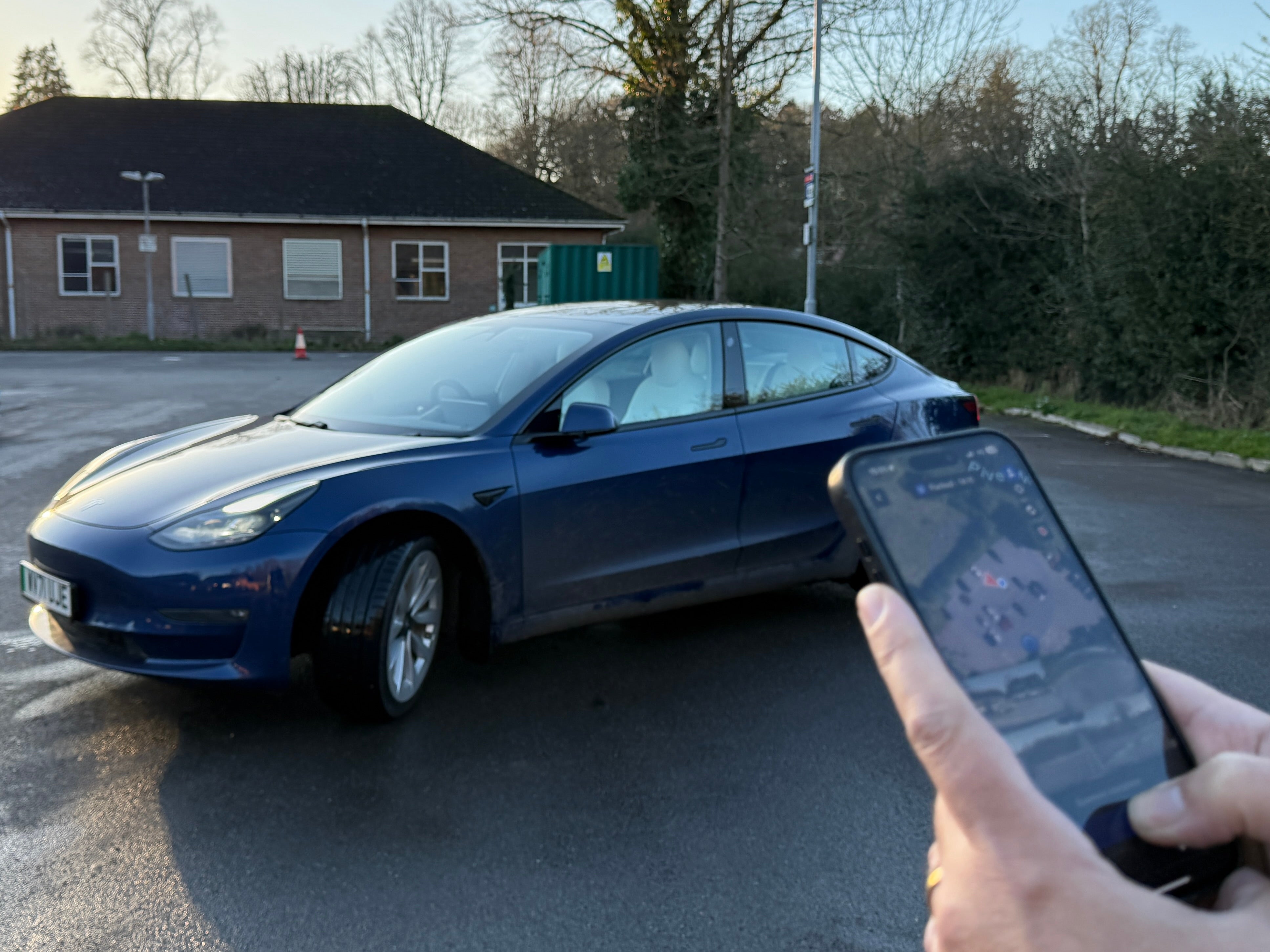
That includes Summon - or Actual Smart Summon (ASS!) to give it its full name. Summon does what you might expect, it brings the car to you (within a short distance) which I tested in an empty car park just to be sure. How often have you found yourself in a car park where somebody has parked so close to you that it might make it physically impossible to get in through the door (more of a problem for us ‘bigger boned’ folk, admittedly)? Many a time I’ve ungraciously clambered over the passenger seat, or even into the car through the boot. Tesla Summon will either just roll the car out of the space or – as I found out – pretty much bring the car direct to you, turning in the process.
I’d experienced it over a longer distance when visiting our US family with their Model Y that’s equipped with Full Self Driving (see below), and it drove probably around 20 meters to meet us. My car made sure I was much closer, but still steered itself out of a space and round towards me.
Unsurprisingly, Summon does exactly the opposite - it will roll the car backwards into a space, too.
I’ve also been playing with the self-parking feature in the car. Most self-parking systems I steadfastly ignore, confident that a DIY approach is quicker and easier. But the system in the Tesla is the best I’ve yet tried – it identifies a parking space quickly, you jab the screen to select the space, then hit the park button and the car swiftly steers itself into the space. It’s much quicker, easier and more trustworthy than other systems I’ve tried.
Among the various other upgrades over the air, including the usual bug fixes, the Tesla app on my Apple Watch has also sprung into life. It means I can do many of the things I can with the phone app on my watch, including using it as a key. The Tesla key cards that I got with the car have stayed in our key cabinet since I’ve had my Model 3 – I’ve used my phone as the key. You only have to approach the car and it’ll unlock for you, locking it and playing a pre-set sound (which you can personalise) as you walk away. The car will operate just fine with the phone – or now my watch – in the car.
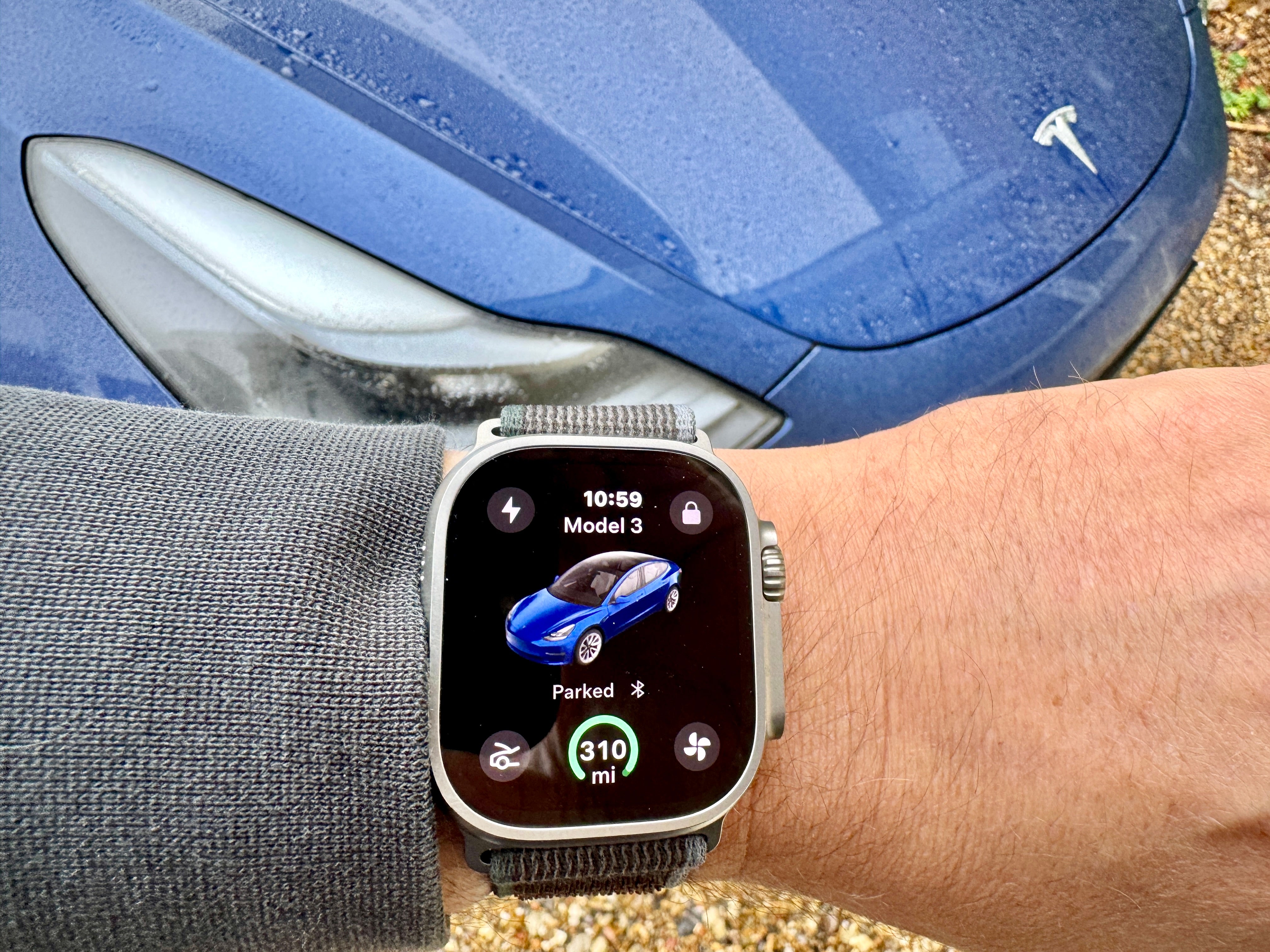
The only oddity about this feature is that the key can either be on my phone or my watch, but not both at the same time. I have to pair (a moment’s job, to be fair) one if I’ve just used the other. However, using your phone as your car key is just so convenient, although just walking out of the house to go to the car has meant I’ve forgotten to take my house keys along... Oops.
There’s plenty of other tech on board I haven’t yet used; the games or watching a movie for example. And, like most EV owners who have charging at home, I’ve not yet used the Tesla Supercharging network, although I’ve set up my account so I should be able to just charge and go. I’ll be testing that out in a couple of weeks.
Week three - Tesla self-driving
Every Tesla bought through the brand’s certified pre-owned scheme gets an upgrade to ‘enhanced autopilot’, whether it had it originally fitted or not. It’s a £3,400 option on a new Model 3 so a real benefit on a used car, and I’ve been giving it a go in the UK with, mostly, impressive results.
Enhanced autopilot is Tesla’s name for its semi-autonomous technology that we can use in the UK. It’s an adaptive cruise control system that will drive the car for you, keeping the car in lane and keeping a set distance from the car in front (that you can adjust). You have to remain in control, but keeping your hands on the wheel, but it’s a feature I love that I find makes longer, more tedious journeys that bit more relaxing.
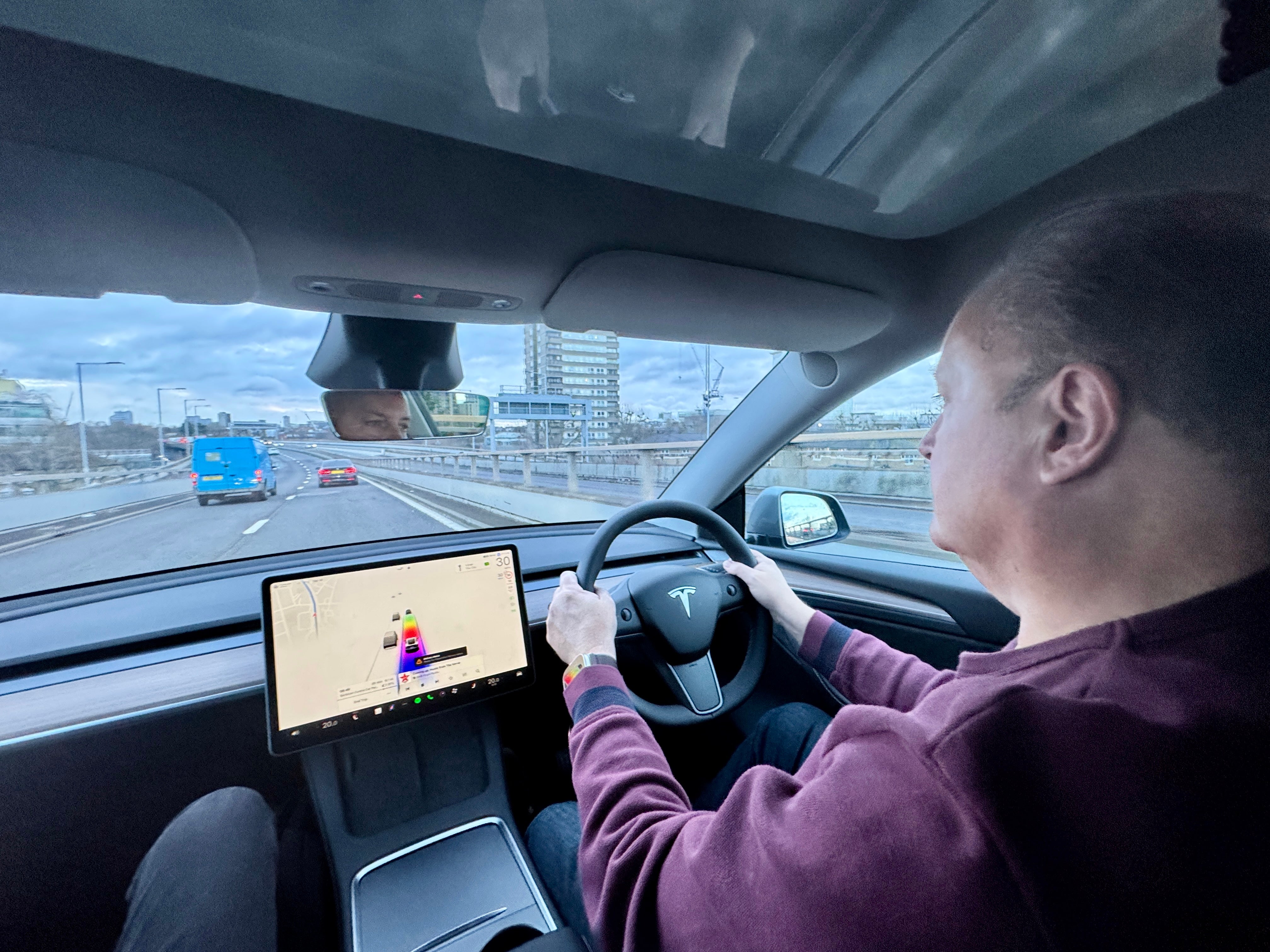
Tesla’s system goes a little further than most by helping you change lanes – it will identify when it’s safe to do so when you’ve initiated a lane change, then with a little wiggle of the steering wheel to remind the system that you’re still there, the car safely changes lanes. It’s clever stuff.
With the navigation set, enhanced autopilot will also advise you when to change lanes or when to take an exit on the motorway. And updates to come will give you ‘summon’ ability – the car will exit a parking space and come to you while you’re standing outside the car.
It’s certainly one of the better systems I’ve used – and I’ve used them all – but like them all, you do have to remain in control. There are occasions where it gets a bit flummoxed by lane markings on the road, or gets a bit scared by other cars or motorbikes straying into your lane and slams the brakes on – you have to be quick on the throttle to avoid upsetting the car behind.
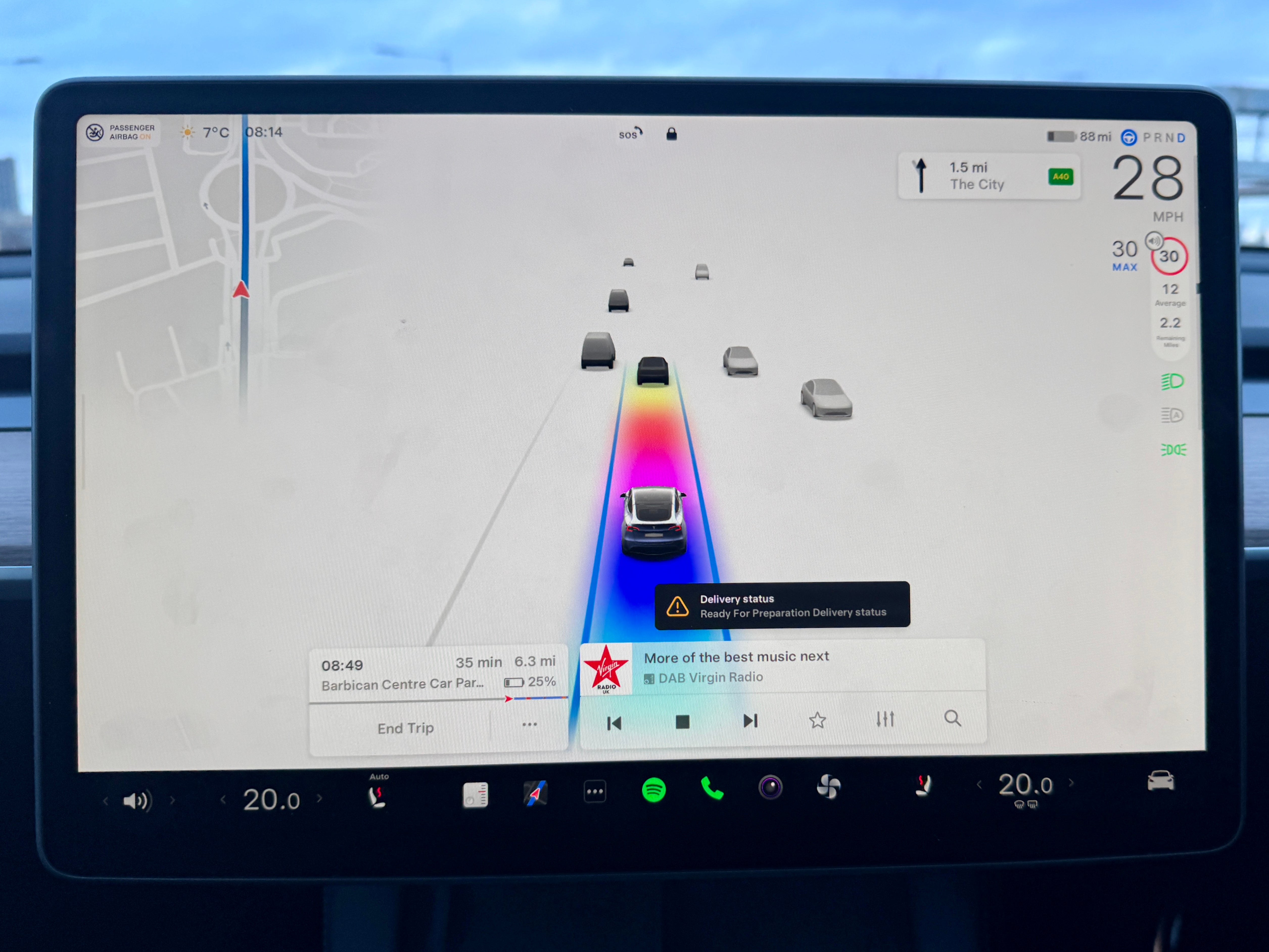
One minor frustration is that it needs constant reminding that you’re there and alert on straight roads. It needs regular steering inputs – which you’re unlikely to do on a straight road – otherwise you get visual and eventually audible alerts asking you to move the steering wheel. So you end up periodically wiggling the steering wheel when you don’t have to, just to remind the system that you’re awake.
On longer motorway journeys it really does make life a little more relaxing, though, and I’ve experienced in both my Model 3 and a brand new Model Y seven-seater that I’ve had in on test. As a bit of a geek, I love knowing the tech is all working hard; the combinations of cameras, sensors and serious computing power. And, as my car has, the system gets better with software updates.
The potential of full self-driving is still a little way off in the UK – even though you can equip your car with the kit to do it, when legislation allows. It’s all systems go in the US, though, as I experienced in my test drive in a Tesla Cybertruck.
But on a recent trip to stay with my folks in Arizona, Ralph and Marsha Grimes, we took a much longer journey on full self-driving - and I mean full self-driving. Ralph is loving his new Tesla Model Y, even more so with the technology on board. And we used it to do a full 70-mile round trip with the car driving itself from the moment Ralph left his drive in Sun City West, following the navigation all the way to wonderful western town Wickenburg and back again. It even managed to negotiate the combination of barriers and gates at the entrance and exit to the development where Ralph and Marsha live.
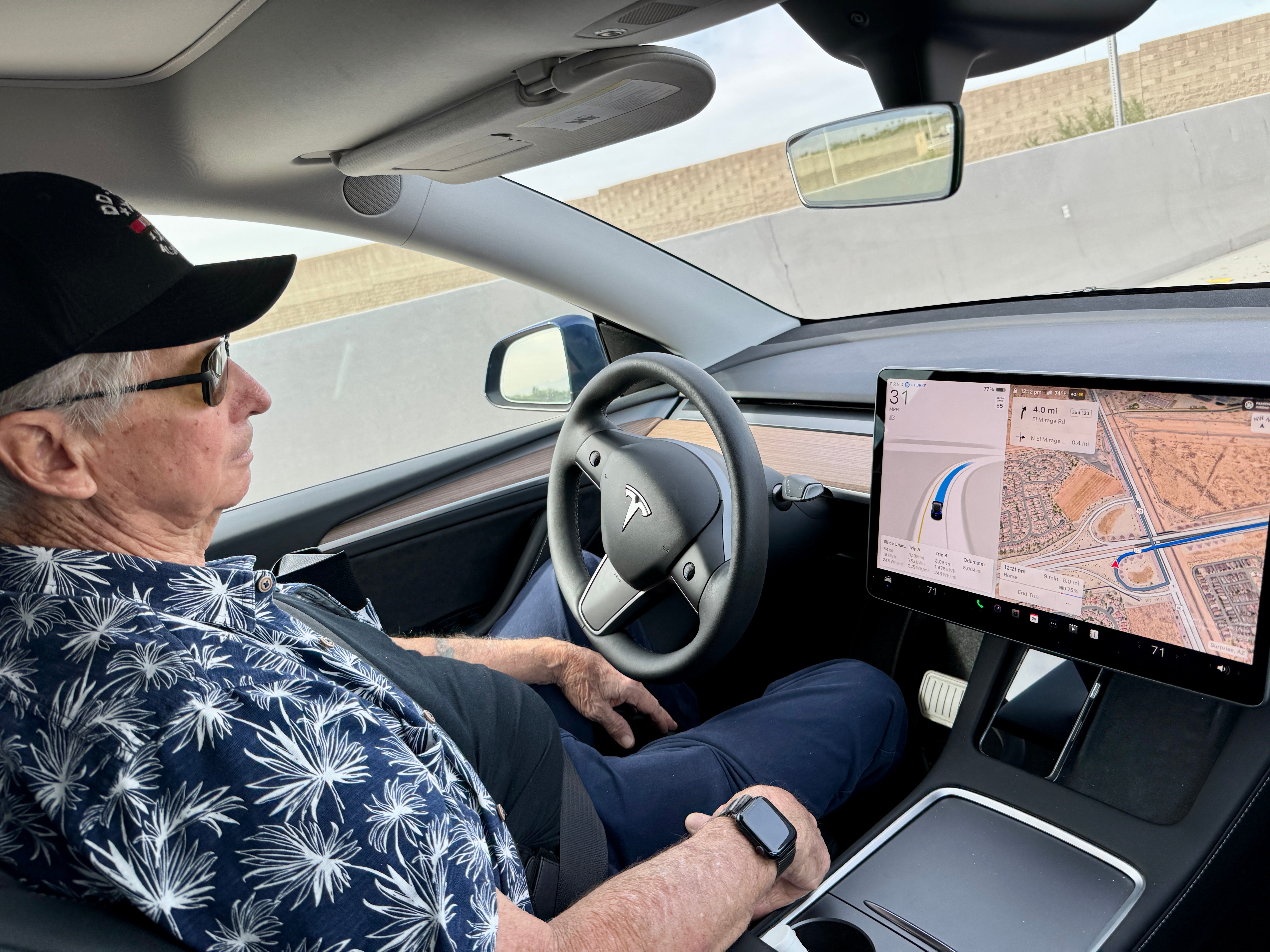
Unlike enhanced autopilot, you don’t even have to keep your hands on the steering wheel with full self-driving – you can sit with your hands in your lap, but you do have to keep watching the road; cameras inside the car are keeping an eye on you making sure you’re not just watching Netflix. And I have to admit I was hugely impressed, sitting watching Ralph with his arms folded and the car navigating bends, traffic lights, lane changes, highway exits, crossing traffic and even spotting barriers.
As for my car, I’ll continue to put enhanced autopilot to good use. You have to know how it works and where it might need you to take over, but for me the benefits outweigh the negatives.
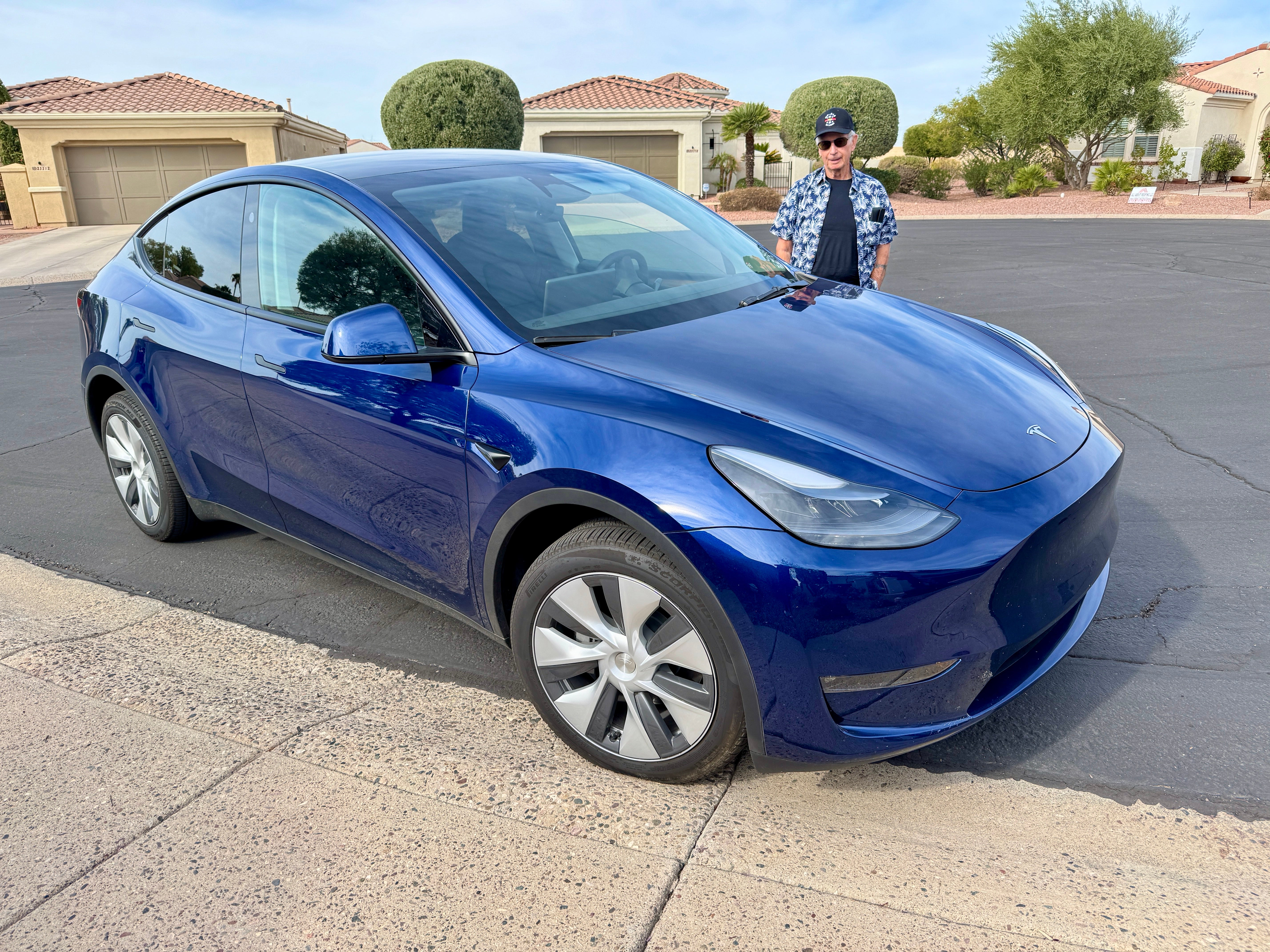
Week two - how good is a used Tesla Model 3’s battery?
The most common question I’m asked about my Model 3 is how well the battery is lasting – and research shows that’s one of the biggest concern for anyone buying an EV, new or used.
A few months ago, I drove a nine year-old Tesla Model S with 254,000 miles on the clock and it still had 84 per cent of its original capacity, meaning a potential range of over 250 miles for that well used model.
As for my car, at just over three-years old and with nearly 25,000 miles on the clock, I’m pretty happy with how things are looking battery-wise. Tesla says that you should expect less than ten per cent degradation in the first few years. So, with the claimed maximum range of my car when it was new at 360-miles, my car should have at least 324 miles range.
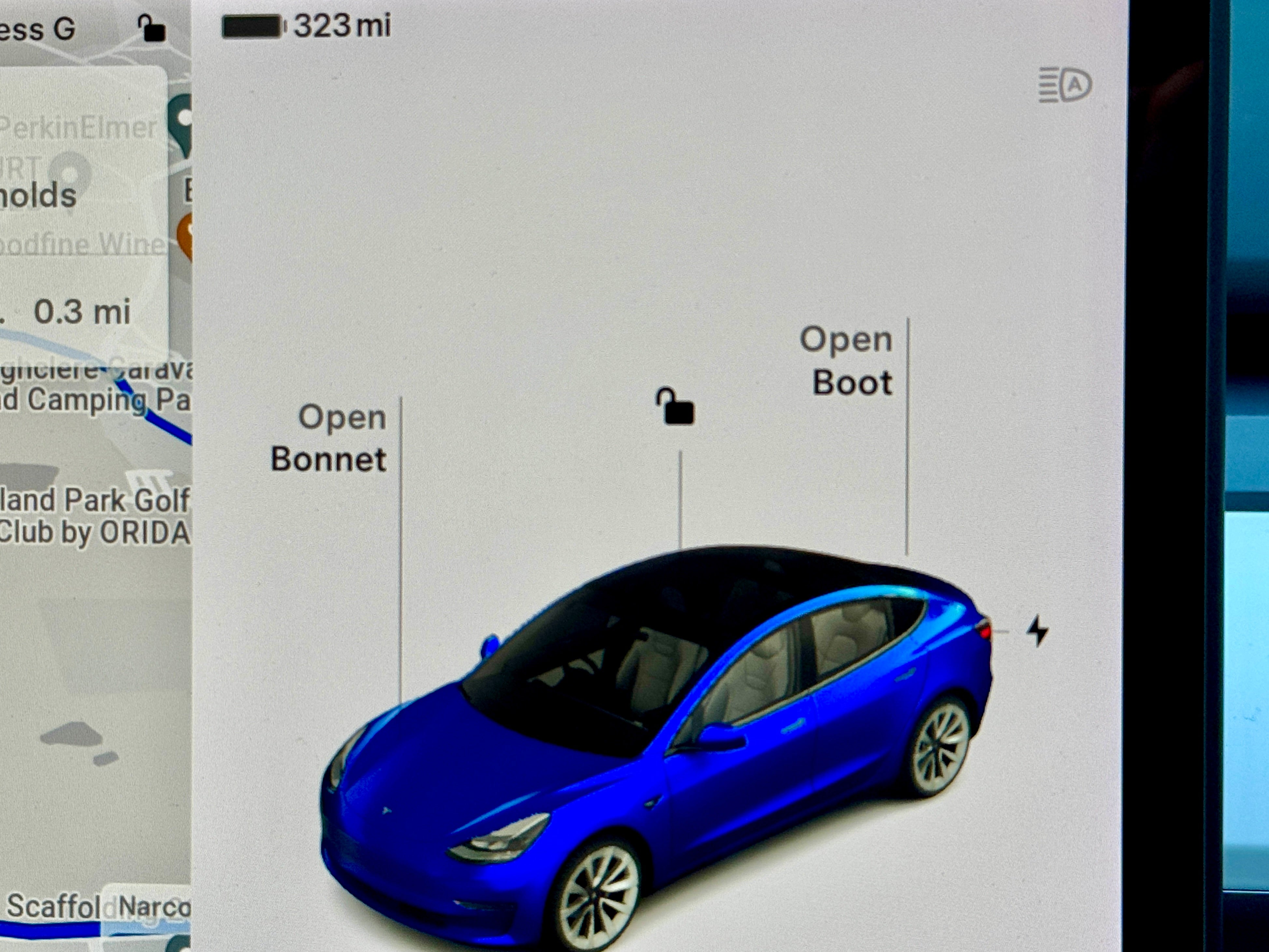
As you can see from the picture above, that’s pretty much exactly what a full charge gives me. But there are two things to bear in mind: firstly, that charge was completed overnight in temperatures of around three degrees Celsius, when I would expect the range to be lower – EV batteries do not perform best in the cold. I’d expect that to be better when the weather is warmer. Secondly, most of the driving I’ve done so far in my Model 3 have been motorway miles, where again EVs are not at their most efficient. The official testing procedure that gives car makers their claimed range figures are done in a mixture of driving, including lots of stopping and starting where EVs use energy recovered from braking to put power back into the battery. If I was doing more town driving, I’d expect that range figure to be higher again.
To give you an example of that, I recently travelled from Buckinghamshire to Kent to collect my Dad, then took him to the Tottenham Hotspur Stadium where one of my sons works to take him on a tour. The total round trip (not including walking around the Stadium!) was almost exactly 250 miles. I got home with 33 miles range left, meaning a total potential range on that day of 283 miles. Bear in mind, though, that again most of that was on the motorway, and it was another cold day.
In summary, I’m happy. I think balancing it out across a year with different temperatures and different types of driving, getting over 300 miles-worth of use out of the battery is entirely do-able, probably closer to around 330. And I’m comfortable in the knowledge that with purely motorway driving, a 250-mile range in cold weather is easily achievable, too. In fact, yesterday I did a 190-mile round-trip on the motorway and still had 60 miles range left.
What quickly becomes apparent when you’re driving any EV is that you learn to manage the mileage, working out how far you’re going, whether you need to charge en route or when you get there, or whether you can get there and back and charge again at home if you have a home charger.
As for the rest of the used Tesla Model 3 experience, passengers can barely believe it’s a used car, the quality and condition of the car is so good. I’ve started to explore and enjoy Enhanced Autopilot doing much of the work on the motorway, and the quality of the engineering and responsiveness of the drivetrain has also impressed me. Only the slightly stiff ride is a slight disappointment, although passengers report that it’s worse in the back than the front.
Finally, for now, I can’t get enough of the view out – the deep front windscreen is a joy to sit behind and makes me wonder why, when there’s no engine up front, more car makers don’t improve forward visibility with big, deep windscreens.
Week one - first impressions of my used Tesla Model 3
In Tesla-speak, ‘certified pre-owned’ means the same as ‘approved used’. These cars have been through a series of thorough checks before being re-sold by Tesla through its network of dealers. They also come with decent warranty coverage.
When Vauxhall launched the UK’s first ‘approved used’ scheme, the tagline was “treating used cars like new” and that certainly seems to be the case with Tesla, too.
Let’s start with the ordering process for a certified pre-owned Tesla, which is pretty much the same as ordering a new one – it’s all done online. You have free choice of the cars in stock around the country, and you’re welcome to test drive a car local to you, or go to the car’s location to test drive it. If you choose to buy, the car can be delivered to you locally, too.
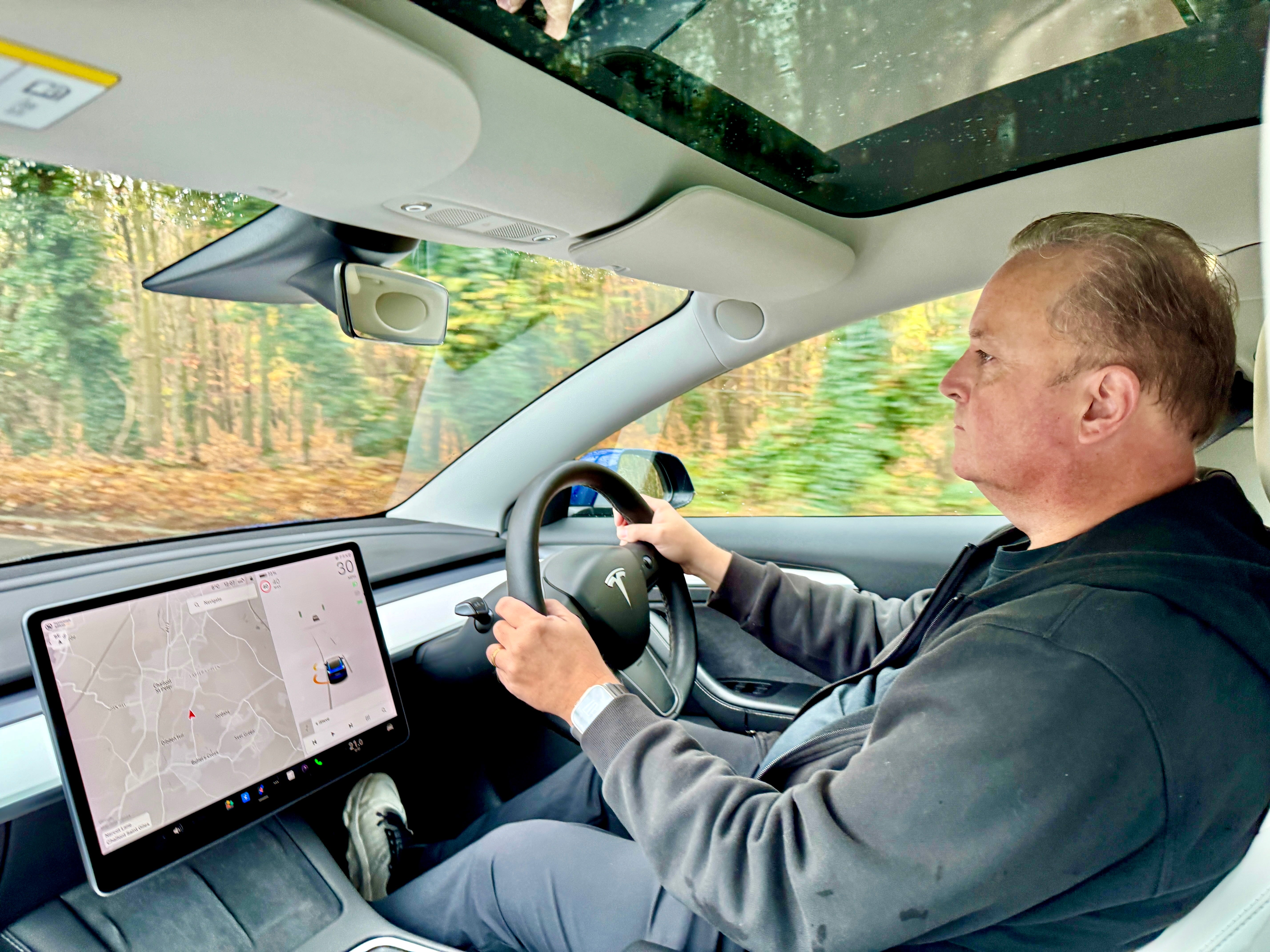
My deep blue metallic Model 3 long range all-wheel drive turned up in absolutely pristine condition. I’m a hard bloke to impress, but the condition of my car was so good that my wife genuinely thought it was a brand-new car.
Considering my pre-owned Tesla Model 3 had 24,000 miles on it, the bodywork – and more surprisingly the white leather interior – were all completely unmarked. My car had also been cleaned and polished to a high standard, so was gleaming when it turned up. It sat smartly on its 19-inch sports wheels.
There’s not much difference in spec between one Tesla and another, but every certified pre-owned model gets an upgrade to ‘enhanced autopilot’ – Tesla’s autonomous driving tech – whether it already had it or not. The white leather was also an upgrade when this car was new.
A factory-fresh Tesla Model 3 starts at £49,900, but this 2021 car cost £28,400 through Tesla’s certified pre-owned service. As well as the upgrade to autopilot enhanced, it came with a brand-new MoT and one remaining year of the standard Tesla warranty, which will run out in September 2025. The battery cover will continue until 2029.
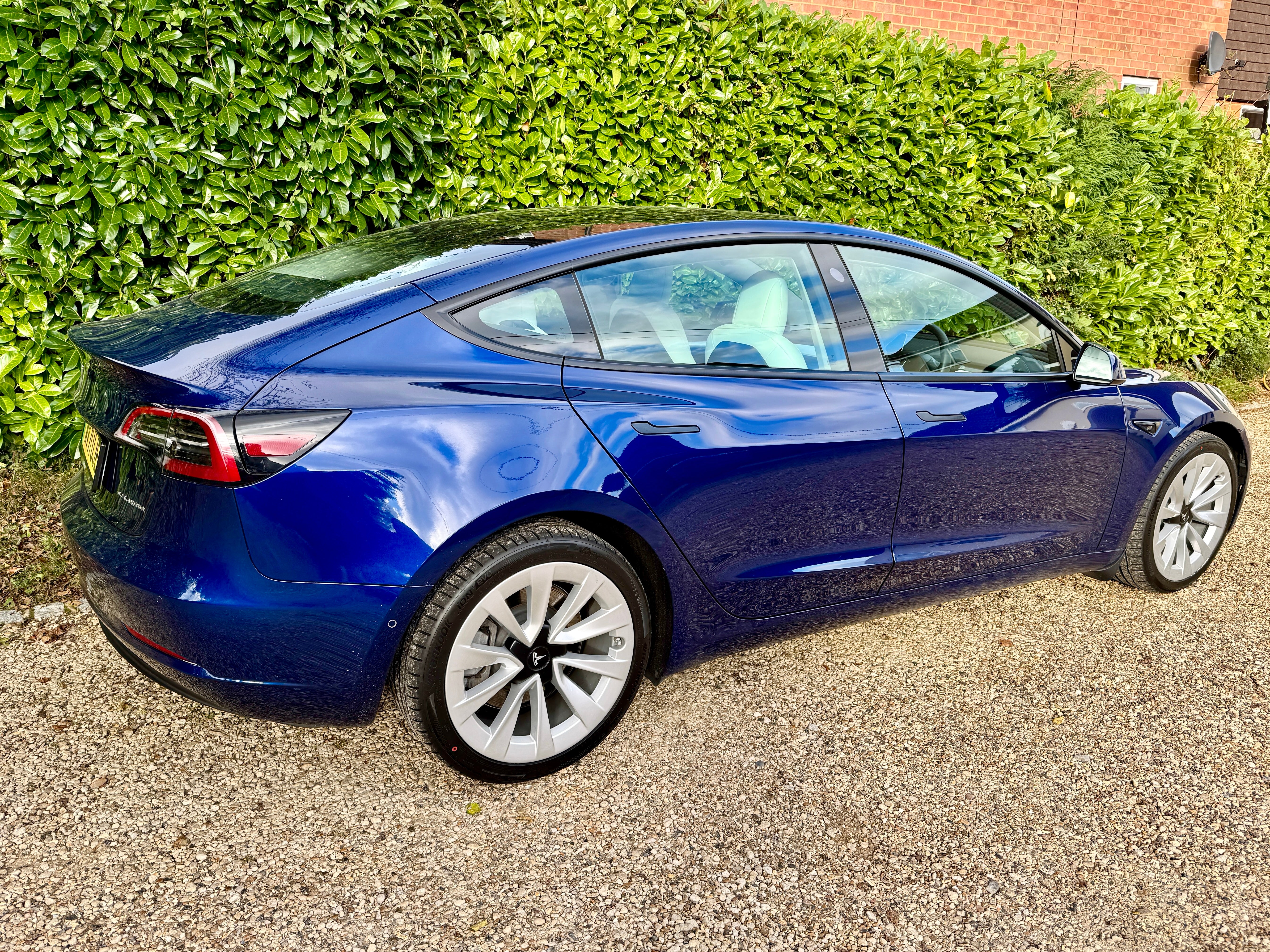
Anyone taking delivery of a Tesla – new or used – should take the time to connect their phone, get logged into the Tesla app, and set up the various functions and apps on the car to their liking. This can take some time, but is absolutely worthwhile. Being the child that I am, I went straight for the emissions testing mode that emits fart sounds outside the car – hilarious (for me, at least).
Getting used to that giant touchscreen isn’t the big deal it might seem. Ultimately you keep your eyes on the road and only glance at the speedo in the top right-hand corner. I tend to keep the map open on the left of the screen, while the right screen shows what the car can “see” around you, identifying cars, pedestrians, cones and even wheelie bins.
As for driving, again the certified pre-owned Tesla Model 3 feels like new. The performance is addictive, with just a squeeze of the throttle pinning you to the back of your seat. Lifting off and feeling the one-pedal driving mode instantly slow the car is just as much fun. It all adds up to feeling like a really well-engineered car with lots of thought as to how the owner will use and want to drive it.
This first generation Tesla Model 3 has a slightly stiff ride – time will tell if that becomes a frustration – and there are also a few creaks around the cabin. But generally, the build quality of my China-built Model 3 seems good. We’re making good use of the twin wireless phone chargers at the front, the deep storage bin in the centre of the car, and the frunk under the bonnet has served us well on several trips to Tesco.
I can already feel myself getting attached to my Tesla Model 3, regardless of those 27,000 miles on the clock. The car’s maximum claimed range, which I’ve yet to put to the test, is a very reasonable 360 miles. I look forward to seeing how realistic that is in my next update.







